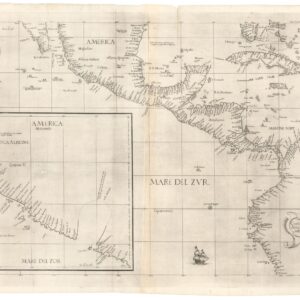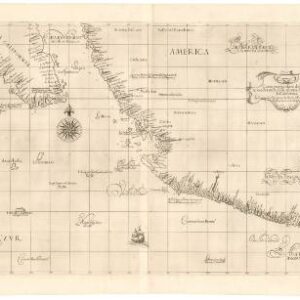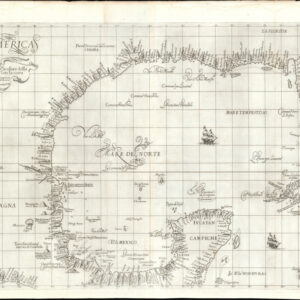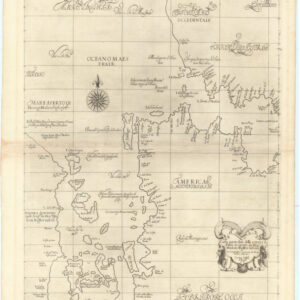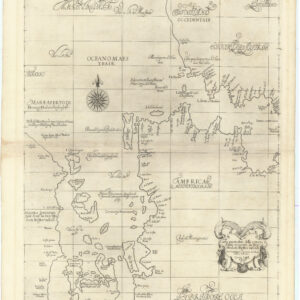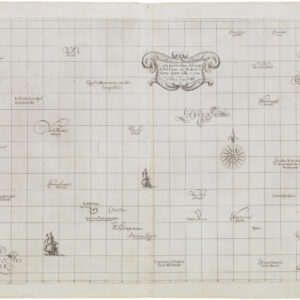Sir Robert Dudley (1574-1649) was an English polymath specializing in navigation, shipbuilding, and cartography. We hold him to be one of the most interesting and important cartographic thinkers in the 17th century, and a bold and daring man to boot. He was seemingly the illegitimate son of Robert Dudley, the Earl of Leicester; a somewhat dubious character who has become famous for being Queen Elizabeth I’s boy-toy. We say ‘seemingly illegitimate’ because much of Dudley’s later life was spent trying to gain the Crown’s recognition as his father’s formal heir. Despite his standing as a bastard, Dudley enjoyed great access to the English Court, at least during Elizabeth’s lifetime, and he would was likely schooled by the greatest teachers of the age.
His father was one of the major financial backers behind Sir Francis Drake’s voyage that circumnavigated the earth, allowing Dudley not only access to ship’s logs and manuscript charts, but also private conversations and personal insights — all from a very early age. Another great Elizabethan explorer, Sir Walter Raleigh, appears to have been his personal tutor at some stage (possibly during Raleigh’s first period of captivity in the Tower of London).
At the age of 17, Dudley was ready to marry, and it was arranged that he would wed the courtier Frances Vasavour. While the Queen approved of the union, she apparently thought it premature due the couple’s young age. This lead Vasavour to marry another man in secret and Dudley to find a new prospective consort. She came in the form of Margaret, the daughter of a wealthy merchant with good connections at court. Margaret was the sister of Sir Thomas Cavendish, the first Englishman to emulate Drake’s bold attack on the Spanish and his subsequent flight across the Pacific. Cavendish was only the fifth man in history to circumnavigate the globe and a key figure in shaping the young Dudley to become an explorer himself. The opportunity to pursue this dream came sooner than expected, in that Margaret’s father gave the couple two fully equipped vessels as a wedding present (or possible dowry). The Leicester and Roebuck allowed Dudley to organize his first maritime expeditions and gain experience as a fleet commander. Having had little prospect of following in his father’s footsteps by inheriting his titles and lands, Dudley now set his eye keenly on the role of explorer and privateer.
The Elizabethan Era was a time of expansion — both of the empire and of the mind. Advanced ship’s technology, combined with generations of mapping and a considerable degree of grit and courage, had allowed Europeans to break free of their own continent and engage – for better or worse – with the rest of the world. The problem was, of course, that there were several European entities vying for the same prize. Among the strongest contesters in the 16th century were the Spanish, English, Portuguese, and Dutch, but the Treaty of Tordesillas (1494) had divided the world between the Spanish and Portuguese, leaving most of the New World in the hands of the Spanish.
Neither the English, nor the Dutch, thought this division was a very good idea, and immediately started challenging the status quo. Wars soon ensued, and for our case, the key conflict was between Spain and England. In many ways, it was this conflict which set the stage for the first English explorers. Both countries understood that an all-out war would be detrimental to their trade and colonization efforts, especially in light of the fact that no party could be assured a final victory. Instead, strained peace accords were repeatedly drawn up and broken, and Spanish suitors lined up to entice the ‘Virgin Queen’ of England into marriage. As a consequence of the strenuous peace efforts and the obvious consequences of war, formal hostilities on the open seas were brought to an end. In the void, the phenomenon of privateering arose, in which formally independent English captains were given a charter to attack and raid Spanish vessels in open waters.
In 1594, Dudley set sail on his first mission, which he was adamant would entail the taking of both Spanish vessels and treasure. He equipped a fleet of four ships — two galleons and two pinnaces — and prepared to set sail for the New World. However, once again the Queen interfered, considering Dudley too young and inexperienced to engage directly with the Spanish in the Caribbean. He was ordered instead to sail on Guyana to patrol the waters there. Dudley experienced some trouble en route, with one of his pinnaces sinking and the other seemingly disappearing during the Atlantic crossing, but he also managed to capture two Spanish vessels, which he manned under his own banner.
Upon arriving in Guyana, Dudley set up base and conducted several shorter expeditions to survey the coast and assess the Spanish positions on the mainland. He anchored for repairs in Cedros Bay on the island of Trinidad. Here he met an indigenous man who promised he would guide them to the fabled city of Eldorado if the group sailed up the Orinoco River. Dudley sent part of his team, but the man abandoned them halfway and the team struggled to make it back to Trinidad. It was not until the spring of 1595 that Dudley sailed north towards Puerto Rico. En route, the fleet captured their first Spanish merchantman, which did wonders for morale.
After this first real success, Dudley and his crew were ready for more and continued north towards Bermuda. A violent storm blew them off course, supposedly pushing Dudley’s flagship, The Beare, as far north as New England. Following this, Dudley returned to Europe, sailing first on the Azores and then on England itself, where he arrived in Cornwall in May of 1595. Once back in European waters, and prior to actually landing back home, Dudley engaged a large Spanish man-of-war in an intense two day battle, which the English supposedly won.
After his return to England, and with the exception of a few more maritime expeditions in the Crown’s name, Dudley set his sights on securing his position in society. His first wife, Margaret Cavendish, had died childless and the year after his return from the New World, Dudley married Alice Leigh. She was the daughter of Sir Thomas Leigh of Stoneleigh, another very wealthy merchant and the former Lord Mayor of London. Now began a long struggle in which Dudley tried to convince the English Court that his parents had in fact been secretly married and that he therefore was entitled to inherit both his father’s (Early of Leicester and Earl of Warwick) and grandfather’s (Duke of Northumberland) titles and lands. The legitimacy of Dudley’s claim was tried by an English court, but following Elizabeth’s death in 1603, some of Dudley’s popularity had waned and Dudley’s petition was ultimately rejected by the Star Chamber. This rejection was later ratified by the newly appointed King James I.
Since both his father and all of the putative witnesses to his parents’ supposed union were dead, and his mother only wrote a vague letter to the court, Dudley’s claim was dismissed on the basis of lacking evidence. Deeply frustrated with the English establishment, Dudley decided to leave England in 1605. He left his wife and children behind and instead took along his cousin, Elizabeth Southwell, disguised as his page. Having arrived well on the continent, the couple declared themselves as converts to Catholicism and were married in Lyon the following year. A papal decree was necessary due to the familial bonds between them, but the fact that Dudley was already married and had children did not figure into the calculation, as this was a marriage executed by a the Church of England and therefore not recognized by the Vatican. The move was not only a snuff to his wife, but to all of English society and it enraged King James so much that he revoked Dudley’s travel license in 1607.
By then Dudley had moved to the Renaissance city of Florence, where he was hired to oversee the design and construction of warships for Ferdinand I, the Grand Duke of Tuscany and head of the Medici Family. During these very fruitful and productive years in Dudley’s life, he continued to cultivate close connections to the English court. In 1611, Dudley sold Kenilworth Castle – his father’s great estate – to the Prince of Wales. But by 1618 Dudley’s influence had waned to such a degree that King James permanently bestowed the earldoms of his father on new members of the nobility. A final effort to be vindicated was made when Dudley convinced Ferdinand II — the new Grand Duke and Holy Roman Emperor — to acknowledge his claim to his grandfather’s title as Duke fo Northumberland. Surprisingly, he seems to have managed this, but rather than swaying opinion in Britain, it only enraged King James further, who responded by halting all attempts at reconciliation.
Dudley remained in the employ of the Grand Duke of Tuscany from 1608 until his death in 1649. During the initial part of this period (1610-1620), he oversaw both the design and construction of a new fleet of ships at the docks in Livorno, while also writing up his many records and diaries into a formal memoir that focussed on navigation and seamanship. Even though the memoirs presumably were secondary to his work in the shipyards, the consolidation of his personal notes, thoughts, and experiences into memoir form nevertheless constituted an ideal foundation for his true masterwork: Dell’Arcano del Mare.
In 1644, shortly before publishing this work, news arrived from England that King Charles I had granted Dudley’s second wife, Alice, the title of Duchess for life. This was in effect a recognition of Dudley’s legitimacy, but it did not mandate the restoration of his titles or lands. Some years later, in 1649, Robert Dudley died an old man in his villa outside Florence. He was buried at the Church of San Pancrazio in Florence. All of his notes, manuscripts, tools, and scientific instruments were bequeathed to Ferdinand II and the House of Medici, where they remain to this day. Many of his original maps and instruments are on permanent display at the Museo Galileo.
Dell’Arcano del Mare (‘Secret of the Sea’) was a seminal publication by any measure. It was the first printed nautical atlas in history and the first time an atlas fully applied the new spatial projection model that had been promulgated by Gerard Mercator in the late 16th century. The complete work consisted of six volumes that Dudley published himself over several years (1645-47). The Arcano included 130 charts, all of which Dudley had designed and compiled himself, and which did not build on previously issued maps. This was completely unheard of and could well have been deemed frivolous and arrogant, had it not been for the sheer quality and consistent reliability of his work.
The maps were engraved by the master-hand of Antonio Francesco Lucini, who stated that he spent 12 years and used 5,000 pounds of copper to produce the plates. The charts are indeed of exceptional quality, both in regard to accuracy and innovation, but also in regard to craftsmanship and aesthetics. In addition to the unique maps, the Arcano included abundant information on navigation, astronomy, maneuverability, ships’ design, construction methods, and defensive features. It even contained a concrete proposal for a new Tuscan fleet, which was to consist of five different types of new ships, all of which were designed and meticulously described by Dudley in this massive work.
-
- Add to cart
- California, Cuba, West Indies, Caribbean, Mexico - Central & South America
Carta prima generale d’America dell’India Occidentale e Mare del Zur
- $4,800
- The earliest published sea chart to focus on the California coast!
Archived
- Out of Stock
- California, Mexico - Central & South America
Carta particolare della parte ocidentale dell nuoua Spagnia è della California. La longitudine Comincia da l’Isola di Pico d’Asores. D’America Carta XXXI.
- Dudley’s Sea Chart from Southern Baja California to South of Acapulco.
- Read more
-
- Out of Stock
- Featured Maps & Views, Texas and The West, United States
Carta particolare della Baia di Messico con la Costa.
- The quintessential explorer’s map: the first printed sea chart of the Gulf of Mexico, from one of the most interesting and important characters in the pantheon of pioneer cartographers.
- Read more
-
- Out of Stock
- Canada and The Great Lakes
Carta particolare dello istreto e Mare iscoperto da Hen:º Hudson Ingilese nel. 1611…
- An essential map for Canada collectors: the first sea chart of Hudson Bay and Hudson Strait, leaving open the possibility of a Northwest Passage.
- Read more
-
- Out of Stock
- Africa
Carta Particolare del Mare di Ethiopia con l’Isola di S. Elena e Parte della Costa. Carta VIIII
- First state of Dudley's magnificent 1645 sea chart off West Africa
- Read more
-
